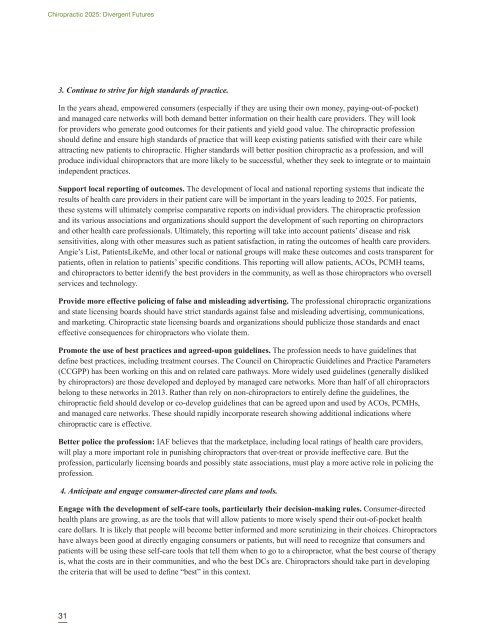Chiropractic 2025:
Chiropractic 2025:
Chiropractic 2025:
Create successful ePaper yourself
Turn your PDF publications into a flip-book with our unique Google optimized e-Paper software.
<strong>Chiropractic</strong> <strong>2025</strong>: Divergent Futures<br />
3. Continue to strive for high standards of practice.<br />
In the years ahead, empowered consumers (especially if they are using their own money, paying-out-of-pocket)<br />
and managed care networks will both demand better information on their health care providers. They will look<br />
for providers who generate good outcomes for their patients and yield good value. The chiropractic profession<br />
should define and ensure high standards of practice that will keep existing patients satisfied with their care while<br />
attracting new patients to chiropractic. Higher standards will better position chiropractic as a profession, and will<br />
produce individual chiropractors that are more likely to be successful, whether they seek to integrate or to maintain<br />
independent practices.<br />
Support local reporting of outcomes. The development of local and national reporting systems that indicate the<br />
results of health care providers in their patient care will be important in the years leading to <strong>2025</strong>. For patients,<br />
these systems will ultimately comprise comparative reports on individual providers. The chiropractic profession<br />
and its various associations and organizations should support the development of such reporting on chiropractors<br />
and other health care professionals. Ultimately, this reporting will take into account patients’ disease and risk<br />
sensitivities, along with other measures such as patient satisfaction, in rating the outcomes of health care providers.<br />
Angie’s List, PatientsLikeMe, and other local or national groups will make these outcomes and costs transparent for<br />
patients, often in relation to patients’ specific conditions. This reporting will allow patients, ACOs, PCMH teams,<br />
and chiropractors to better identify the best providers in the community, as well as those chiropractors who oversell<br />
services and technology.<br />
Provide more effective policing of false and misleading advertising. The professional chiropractic organizations<br />
and state licensing boards should have strict standards against false and misleading advertising, communications,<br />
and marketing. <strong>Chiropractic</strong> state licensing boards and organizations should publicize those standards and enact<br />
effective consequences for chiropractors who violate them.<br />
Promote the use of best practices and agreed-upon guidelines. The profession needs to have guidelines that<br />
define best practices, including treatment courses. The Council on <strong>Chiropractic</strong> Guidelines and Practice Parameters<br />
(CCGPP) has been working on this and on related care pathways. More widely used guidelines (generally disliked<br />
by chiropractors) are those developed and deployed by managed care networks. More than half of all chiropractors<br />
belong to these networks in 2013. Rather than rely on non-chiropractors to entirely define the guidelines, the<br />
chiropractic field should develop or co-develop guidelines that can be agreed upon and used by ACOs, PCMHs,<br />
and managed care networks. These should rapidly incorporate research showing additional indications where<br />
chiropractic care is effective.<br />
Better police the profession: IAF believes that the marketplace, including local ratings of health care providers,<br />
will play a more important role in punishing chiropractors that over-treat or provide ineffective care. But the<br />
profession, particularly licensing boards and possibly state associations, must play a more active role in policing the<br />
profession.<br />
4. Anticipate and engage consumer-directed care plans and tools.<br />
Engage with the development of self-care tools, particularly their decision-making rules. Consumer-directed<br />
health plans are growing, as are the tools that will allow patients to more wisely spend their out-of-pocket health<br />
care dollars. It is likely that people will become better informed and more scrutinizing in their choices. Chiropractors<br />
have always been good at directly engaging consumers or patients, but will need to recognize that consumers and<br />
patients will be using these self-care tools that tell them when to go to a chiropractor, what the best course of therapy<br />
is, what the costs are in their communities, and who the best DCs are. Chiropractors should take part in developing<br />
the criteria that will be used to define “best” in this context.<br />
31


